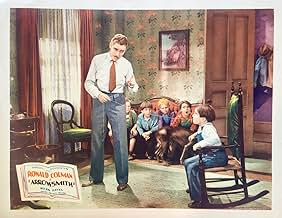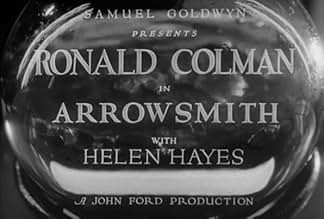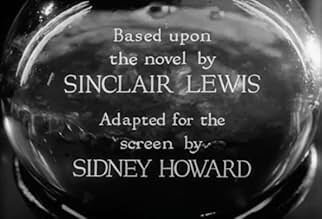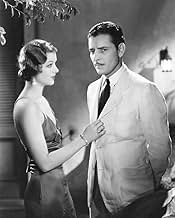AVALIAÇÃO DA IMDb
6,2/10
2,1 mil
SUA AVALIAÇÃO
Adicionar um enredo no seu idiomaA medical researcher is sent to a plague outbreak, where he has to decide priorities for the use of a vaccine.A medical researcher is sent to a plague outbreak, where he has to decide priorities for the use of a vaccine.A medical researcher is sent to a plague outbreak, where he has to decide priorities for the use of a vaccine.
- Direção
- Roteiristas
- Artistas
- Indicado a 4 Oscars
- 4 vitórias e 4 indicações no total
Alec B. Francis
- Twyford
- (as Alec Francis)
Erville Alderson
- Pioneer
- (não creditado)
Beulah Bondi
- Mrs. Tozer
- (não creditado)
Florence Britton
- Miss Twyford
- (não creditado)
Josephine Brown
- West Indies Village Bride
- (não creditado)
Nora Cecil
- Nurse
- (não creditado)
- Direção
- Roteiristas
- Elenco e equipe completos
- Produção, bilheteria e muito mais no IMDbPro
Avaliações em destaque
The student of medical school Martin Arrowsmith (Ronald Colman) dreams on becoming a researcher. He seeks out Professor Max Gottlieb (A.E. Anson) that promises the position when Arrowsmith is an undergraduate doctor. Meanwhile Arrowsmith meets the nurse Leora (Helen Hayes) and they fall in love with each other. When Prof. Gottlieb invites Arrowsmith to work with him in New York, he declines since the salary is not enough to support Leora and him. He marries Leora and becomes a countryside doctor. After a while, the frustrated Arrowsmith decides to move with Leora to New York to work with Gottlieb. Soon he is invited to go to a Caribbean Island where there is an outbreak of bubonic plague to test a serum he has developed in the population and Leora decides to go with him despite the danger. Will Arrowsmith succeed in saving the inhabitants?
"Arrowsmith" is a deceptive film directed by John Ford. The story seems to be incomplete missing explanation, for example, about Mrs. Joyce Lanyon, performed by the gorgeous Myrna Loy. The relationship between Arrowsmith and his wife is also underdeveloped. Ronald Colman is too old for the role of a young idealistic doctor. Maybe the viewer that has read the novel may like this film more than one that has never read it. Last but not the least, the Brazilian title is awful. My vote is five.
Title (Brazil): "Médico e Amante" ("Doctor and Lover")
"Arrowsmith" is a deceptive film directed by John Ford. The story seems to be incomplete missing explanation, for example, about Mrs. Joyce Lanyon, performed by the gorgeous Myrna Loy. The relationship between Arrowsmith and his wife is also underdeveloped. Ronald Colman is too old for the role of a young idealistic doctor. Maybe the viewer that has read the novel may like this film more than one that has never read it. Last but not the least, the Brazilian title is awful. My vote is five.
Title (Brazil): "Médico e Amante" ("Doctor and Lover")
Although the film has not aged well, "Arrowsmith" was well regarded when it was released and garnered four Academy Award nominations including Best Picture. Perhaps in those early days of sound, competent use of the camera and decent recording equipment were regarded as high values that merited praise. However, with the exception of some occasionally striking cinematography by Ray June, this John Ford adaptation of the Sinclair Lewis novel is choppy, unevenly acted, and betrays its age.
Later in the 1930's, Sidney Howard adapted the sprawling historical novel "Gone with the Wind" into a fine screenplay that left viewers with the feeling that they had seen the entire book on screen. However, his adaptation of the Pulitzer Prize Winning "Arrowsmith" omits the core message of the novel and rushes through events in the life of Dr. Martin Arrowsmith in brief vignettes that leave viewers confused. Characters appear and disappear, decisions and moves are made without deliberation or motivation, and Arrowsmith himself comes off as a shallow individual with little regard for either those he supposedly loves or those he supposedly has dedicated his life to saving.
Ronald Colman is generally a fine actor, and his idealism in "Lost Horizon" appeared genuine. However, Colman's suggested idealistic behavior in "Arrowsmith" is not convincing, despite a few effective scenes towards the end of the film. Helen Hayes has a few good scenes as the doctor's wife, although Myrna Loy has little to do but look seductive, which she does quite well.
Unfortunately, the scenes in the Caribbean seem demeaning to the characters, and a local doctor's willingness to allow what is effectively experimentation on his fellow countrymen borders on the criminal. However, these attitudes were considered the norm when the film was made and should be viewed in the context of the period. Although most films seem far too long, "Arrowsmith" is much too short to convey the canvas that Lewis painted in his novel. Almost like a Clift Notes version of the book, John Ford's "Arrowsmith" disappoints, especially when the talent expended on its production is considered.
Later in the 1930's, Sidney Howard adapted the sprawling historical novel "Gone with the Wind" into a fine screenplay that left viewers with the feeling that they had seen the entire book on screen. However, his adaptation of the Pulitzer Prize Winning "Arrowsmith" omits the core message of the novel and rushes through events in the life of Dr. Martin Arrowsmith in brief vignettes that leave viewers confused. Characters appear and disappear, decisions and moves are made without deliberation or motivation, and Arrowsmith himself comes off as a shallow individual with little regard for either those he supposedly loves or those he supposedly has dedicated his life to saving.
Ronald Colman is generally a fine actor, and his idealism in "Lost Horizon" appeared genuine. However, Colman's suggested idealistic behavior in "Arrowsmith" is not convincing, despite a few effective scenes towards the end of the film. Helen Hayes has a few good scenes as the doctor's wife, although Myrna Loy has little to do but look seductive, which she does quite well.
Unfortunately, the scenes in the Caribbean seem demeaning to the characters, and a local doctor's willingness to allow what is effectively experimentation on his fellow countrymen borders on the criminal. However, these attitudes were considered the norm when the film was made and should be viewed in the context of the period. Although most films seem far too long, "Arrowsmith" is much too short to convey the canvas that Lewis painted in his novel. Almost like a Clift Notes version of the book, John Ford's "Arrowsmith" disappoints, especially when the talent expended on its production is considered.
Even though only around a third of John Ford's pictures are westerns, it's still undeniable that his forte or, if you prefer, his comfort zone was in historical pictures of some sort. Arrowsmith is unusual in that it is a contemporary drama that Ford both directed and co-produced.
In spite of the above, you might think this was indeed a western from the opening scene, in which we see an ancestor of the protagonist as a good ol' covered wagon pioneer. This bit of family history is not brought up again, but it was obviously judged by Ford and Sam Goldwyn to be significant enough to open the film with, even though it would have been one of the most expensive scenes of the shoot (unless that opening shot is lifted from somewhere else, which it may well be). The point seems to be to draw a line between the struggles of the pioneers and the main story of a medical scientist torn between his home life and his career. It seems a rather tenuous comparison.
On the other hand, there could be parallels between Dr Arrowsmith and a typical Fordian westerner. Not in the character as written – I'm no auteur theorist – but in the way Ford shoots their environments. In the majority of Ford films he exaggerates the smallness of interiors and the vastness of exteriors. The homestead is safe, yet dull, and the great outdoors is exciting yet dangerous. The village where Arrowsmith practices as a country doctor is shot in much the same way as Ford would a western settlement – cramped interiors, foreground clutter and heavy use of framing. However the medical research centre, while it may be another interior, is shot so as to show off its openness and stark cleanliness, with corridors and waiting rooms so vast they look almost surreal. This is Arrowsmith's "wild west", where he is free to be a pioneer of another sort. Another tenuous comparison? Maybe, but remember directors have many choices of how to shoot a place, regardless of the script or the set design, and these choices will reflect how they view that space and what they feel it means to the story.
While Ford's use of space developed incredibly early on, the camera movement at this stage is not yet of the "invisible camera" technique that later became his standard. For those that don't know, invisible camera means you only move the camera when it's following an action, say for example a character walking to the other end of the room. If everyone in the scene is sitting still, the camera sits still. If it's done properly the audience doesn't notice the camera movement, hence "invisible camera". And yet here there is rather a lot of obtrusive camera movement. This is pretty much in line with the general style of the time, in spite of the myth that cameras were immobilised in the early sound era. Despite a few teething problems that were mostly solved by the end of 1929, cameras of the early talkies zipped around just as giddily of those of the late silents.
Ford is not known to have given his actors much coaching, nor allow them rehearsals or repeated takes to hone their performance. For this reason the acting in his pictures tends to be only as good as the raw talent of the performers. Ronald Coleman and Helen Hayes were both good dramatic actors, and here they give good – but not outstanding – dramatic performances. Richard Bennett however just gives a fairly standard, slightly comical supporting-player performance as Sondelius, and the part should either have been cast differently or he should have been prompted to play it with more conviction.
The story goes that the hard-drinking Ford was contracted by Goldwyn to remain teetotal until the production wrapped. Apparently Ford, eager to get back to the bottle, rushed the shooting even more than usual, tearing pages out of the script wherever he could get away with it. Whether this is true or just another bit of Ford mythology, it certainly makes sense. In particular the love story, crucial to the picture's impact, is massively underdeveloped. Downplaying the romantic angle is actually very typical of Ford, but even the usual Fordian semi-improvised comedy diversions are absent – with the exception of a couple of nice gags in a scene where a boy has his tooth pulled, and an almost surreal moment where a comedy drunk inexplicably wanders on and off the set. The resultant picture is full of great moments, but overall seems a little undernourished. Arrowsmith could have been an intense and poignant drama, but Ford was the wrong man for the job.
In spite of the above, you might think this was indeed a western from the opening scene, in which we see an ancestor of the protagonist as a good ol' covered wagon pioneer. This bit of family history is not brought up again, but it was obviously judged by Ford and Sam Goldwyn to be significant enough to open the film with, even though it would have been one of the most expensive scenes of the shoot (unless that opening shot is lifted from somewhere else, which it may well be). The point seems to be to draw a line between the struggles of the pioneers and the main story of a medical scientist torn between his home life and his career. It seems a rather tenuous comparison.
On the other hand, there could be parallels between Dr Arrowsmith and a typical Fordian westerner. Not in the character as written – I'm no auteur theorist – but in the way Ford shoots their environments. In the majority of Ford films he exaggerates the smallness of interiors and the vastness of exteriors. The homestead is safe, yet dull, and the great outdoors is exciting yet dangerous. The village where Arrowsmith practices as a country doctor is shot in much the same way as Ford would a western settlement – cramped interiors, foreground clutter and heavy use of framing. However the medical research centre, while it may be another interior, is shot so as to show off its openness and stark cleanliness, with corridors and waiting rooms so vast they look almost surreal. This is Arrowsmith's "wild west", where he is free to be a pioneer of another sort. Another tenuous comparison? Maybe, but remember directors have many choices of how to shoot a place, regardless of the script or the set design, and these choices will reflect how they view that space and what they feel it means to the story.
While Ford's use of space developed incredibly early on, the camera movement at this stage is not yet of the "invisible camera" technique that later became his standard. For those that don't know, invisible camera means you only move the camera when it's following an action, say for example a character walking to the other end of the room. If everyone in the scene is sitting still, the camera sits still. If it's done properly the audience doesn't notice the camera movement, hence "invisible camera". And yet here there is rather a lot of obtrusive camera movement. This is pretty much in line with the general style of the time, in spite of the myth that cameras were immobilised in the early sound era. Despite a few teething problems that were mostly solved by the end of 1929, cameras of the early talkies zipped around just as giddily of those of the late silents.
Ford is not known to have given his actors much coaching, nor allow them rehearsals or repeated takes to hone their performance. For this reason the acting in his pictures tends to be only as good as the raw talent of the performers. Ronald Coleman and Helen Hayes were both good dramatic actors, and here they give good – but not outstanding – dramatic performances. Richard Bennett however just gives a fairly standard, slightly comical supporting-player performance as Sondelius, and the part should either have been cast differently or he should have been prompted to play it with more conviction.
The story goes that the hard-drinking Ford was contracted by Goldwyn to remain teetotal until the production wrapped. Apparently Ford, eager to get back to the bottle, rushed the shooting even more than usual, tearing pages out of the script wherever he could get away with it. Whether this is true or just another bit of Ford mythology, it certainly makes sense. In particular the love story, crucial to the picture's impact, is massively underdeveloped. Downplaying the romantic angle is actually very typical of Ford, but even the usual Fordian semi-improvised comedy diversions are absent – with the exception of a couple of nice gags in a scene where a boy has his tooth pulled, and an almost surreal moment where a comedy drunk inexplicably wanders on and off the set. The resultant picture is full of great moments, but overall seems a little undernourished. Arrowsmith could have been an intense and poignant drama, but Ford was the wrong man for the job.
The fact that an idealistic medical doctor was the protagonist in Arrowsmith is the reason why John Ford must have been attracted to this story and agreed to film it for Sam Goldwyn.
Allegedly it was not a happy collaboration. Two very individualistic men wanted to have their imprimatur on the film. They never worked together on a finished product again, though Ford did start filming The Adventures of Marco Polo for Goldwyn and quit.
I read the novel way back in the day when I was in high school and we only get the second half of it. There's a great deal in the book before Ronald Colman as Martin Arrowsmith goes to work for the Research Foundation and A.E. Anson as Max Gottlieb. You miss quite a lot of the character development of Arrowsmith.
Of course the plot mostly centers on Colman and his other mentor, Richard Bennett going to a Caribbean Island where there has been an outbreak of plague. Along for the trip is Helen Hayes who is Colman's wife Leora.
Colman is there to test a new serum and he's under orders as a researcher to only administer the real stuff to half his patient and a placebo to the others as a control group. This is where the racism of the time kicks in as these human guinea pigs are black, probably the descendants of runaway slaves. There is a black doctor named Marchand in the cast played by Oliver Brooks and it is a rarity among black performers at the time in that the role was hardly servile at all. Brooks seems to go along with the controlled experiment, but he becomes one of many in the cast to meet a tragic end.
With some of what came out about the Tuskegee experiments later on Arrowsmith may have been quite on target without knowing it. A harrowing thought.
Colman and Hayes are an attractive pair of leads. Myrna Loy has a much abbreviated role in the film as a New York socialite that Colman meets down in the islands. In the book he has an affair with her and marries her later on. You won't see that here.
Arrowsmith is a good film though I wish more of Lewis's story got into the final product. But it probably would have run for three hours and films just didn't do that back then.
Allegedly it was not a happy collaboration. Two very individualistic men wanted to have their imprimatur on the film. They never worked together on a finished product again, though Ford did start filming The Adventures of Marco Polo for Goldwyn and quit.
I read the novel way back in the day when I was in high school and we only get the second half of it. There's a great deal in the book before Ronald Colman as Martin Arrowsmith goes to work for the Research Foundation and A.E. Anson as Max Gottlieb. You miss quite a lot of the character development of Arrowsmith.
Of course the plot mostly centers on Colman and his other mentor, Richard Bennett going to a Caribbean Island where there has been an outbreak of plague. Along for the trip is Helen Hayes who is Colman's wife Leora.
Colman is there to test a new serum and he's under orders as a researcher to only administer the real stuff to half his patient and a placebo to the others as a control group. This is where the racism of the time kicks in as these human guinea pigs are black, probably the descendants of runaway slaves. There is a black doctor named Marchand in the cast played by Oliver Brooks and it is a rarity among black performers at the time in that the role was hardly servile at all. Brooks seems to go along with the controlled experiment, but he becomes one of many in the cast to meet a tragic end.
With some of what came out about the Tuskegee experiments later on Arrowsmith may have been quite on target without knowing it. A harrowing thought.
Colman and Hayes are an attractive pair of leads. Myrna Loy has a much abbreviated role in the film as a New York socialite that Colman meets down in the islands. In the book he has an affair with her and marries her later on. You won't see that here.
Arrowsmith is a good film though I wish more of Lewis's story got into the final product. But it probably would have run for three hours and films just didn't do that back then.
Ronald Colman,(Dr. Martin Arrowsmith),"A Tale of Two Cities" '35, is a young doctor who starts out in life and desires to progress into the laboratory and look under a microscope all day long. However, he no long completes medical school and meets up with Helen Hayes,(Leora Arrowsmith) and on the first date, asks her to marry him. Martin and Leora are madly in love with each other but it is difficult for Martin to establish himself as a doctor, so they move to South Dakota. Myrna Loy,(Joyce Lanyon),"The Mask of Fu Manchu",'32 plays a sexy gal who has eyes for Martin and could lead to some problems. In 1931 this was a big hit film because of Helen Hayes, a great theatrical actress and Ronald Colman the thrill of most ladies during this period of time. Myrna Loy was young and pretty and getting great attention from Hollywood and the general audiences. There was plenty of smoking through out this film and it clearly shows how the world has finally changed about its view on smoking.
Você sabia?
- CuriosidadesCensorship at the time meant that the subplot of Arrowsmith's liaison with another woman while still married meant that most of Myrna Loy's scenes were drastically cut. Although every attempt was made to restore the present version to its original length, there are still about 10 minutes missing.
- Erros de gravaçãoArrowsmith conducts a trial of his serum by giving it to half the potential plague victims and giving the other half nothing. Anyone who tried this in real life would provoke protests, if not riots. So these trials are conducted by giving half the people a placebo and not telling anyone which they are getting.
- Citações
Dr. Martin Arrowsmith: God give me clear eyes and freedom from haste. God give me anger against all pretense. God keep me looking for my own mistakes. God keep me at it till my results are proven. God give me strength not to trust to God.
- Cenas durante ou pós-créditosOpening credits prologue: The story of a man who dedicated his life to service and his heart to the love of one woman.
- Versões alternativasMyrna Loy's role was substantially reduced when the film was reissued because the Production Code had taken effect. The missing scenes have been restored on the DVD.
- ConexõesReferenced in Cidadão Kane (1941)
- Trilhas sonorasWilliam Tell Overture
(1829) (uncredited)
Written by Gioachino Rossini
Played on piano from a recording
Principais escolhas
Faça login para avaliar e ver a lista de recomendações personalizadas
- How long is Arrowsmith?Fornecido pela Alexa
Detalhes
- Data de lançamento
- País de origem
- Idiomas
- Também conhecido como
- Arrowsmith
- Locações de filme
- Empresas de produção
- Consulte mais créditos da empresa na IMDbPro
- Tempo de duração1 hora 48 minutos
- Cor
- Proporção
- 1.20 : 1
Contribua para esta página
Sugerir uma alteração ou adicionar conteúdo ausente





































